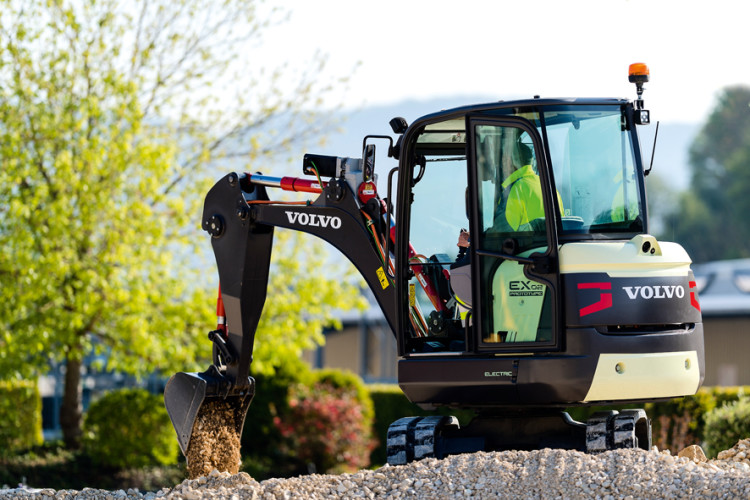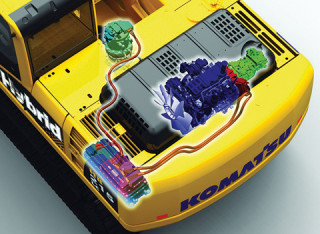Electric vehicles will gradually overtake diesel-powered machines in the construction industry over the next 10 years, according to a new report from IDTechEx, an independent market research consultancy specialising in emerging technology.
The study, entitled Electric Vehicles in Construction, Agriculture and Mining 2019-2029, says that “only 15% of CAM (Construction, Agriculture and Mining) vehicles sold today are EVs (Electric Vehicles) but it will be the majority sold in 2029. Indeed, CAM vehicle profitability will remain superior.”
Diesel, the authors argue, will be squeezed out over the next decade by increasing regulation that will increase overall costs. At the same time, the cost of owning electric vehicles will decrease until their purchase price is the same, or less, than their diesel-powered equivalents.
“And that’s the killer blow,” says author and IDTechEX chairman Dr Peter Harrop. He argues that the market for construction vehicles will follow the same path as other markets for electric vehicles. He gives the example of golf carts.
“Twenty years ago golf clubs would buy petrol-powered carts rather than electric ones because they were cheaper to buy, though electric carts were cheaper to run. But, just 10 years ago, everyone switched to electric because it was cheaper to buy and cheaper to run than the petrol-powered equivalent,” he says.
The pressure upon diesel from tightening legislation covering CO2 emissions, particulate emissions and NO2 emissions will make it harder and harder to produce diesel engines that conform.
“It won’t necessarily be the end of diesel or mean that diesel will be illegal but it will become very expensive to fit the extra equipment that will make a diesel engine legal,” Harrop predicts. “As research continues, scientists are finding more and more health issues associated with diesel fumes, particulates and nitrogen dioxide (NO2) – childhood asthma, for instance, or the increased risk of miscarriages. So it will become increasingly difficult to operate diesel-powered machinery in cities.”
If expense and regulations are the stick, then efficiency, reduced maintenance and reduced environmental impact are the carrots for manufacturers and users alike. Electric drivetrains are up to three times more efficient than their diesel equivalents, argues Harrop, and they achieve this with far fewer moving parts – 5% – so there is less to go wrong. As JCB pointed out last year at the launch of the its first-ever electric excavator, the 19C-1 E-TEC, “there are fewer daily checks, as it has no engine oil, coolant or fuel tank”.
And the efficiency of electric vehicles is continuing to improve as the associated technologies and infrastructure develop. A suitable electric drivetrain can power tools such as grabs and even recover gravitational or rotational braking energy as electricity back into the battery.
The introduction of supercapacitors for energy recovery and storage has greatly increased the scope for storing the energy that can be recovered or generated in an electric vehicle.
For instance, supercapacitors can recover up to 80% of the kinetic energy used in activities such as braking both the vehicle itself and its swinging, digging and lifting mechanisms. By contrast, says Harrop, a conventional diesel-powered machine would simply wear out brake discs which would then need replacing.
Yet it is the secondary benefits that he sees as most immediately attractive; the lack of fumes and noise not only makes electric vehicles less polluting but also means they can operate for far longer than a diesel equivalent. “JCB customers were only allowed to work four hours a day in some cities yet they can work far longer with the new electric machines so the payback is faster and the profit involved far higher,” he says.
JCB itself says that too. “The 19C-1 E-TEC will provide contractors with a zero-emission, low-noise solution, allowing them to work independently, in late night urban conditions, within buildings and even in rail tunnels with no requirement for costly exhaust extraction equipment,” was how JCB chief innovation and growth officer Tim Burnhope put it.
There seems, as Harrop says, to be a strong groundswell favouring electric drivetrains among the manufacturers for construction vehicles. Certainly, the latest Intermat trade show would seem to back that view. The show – one of the three big global showcases for the latest developments in construction equipment – is a bellwether for the direction in which most manufacturers are headed.
Held over five days in Paris, last year’s event emphasised the growing interest in electric vehicles as many exhibitors put their latest hybrid or electrically powered equipment to the fore. The Intermat 2018 Innovation Award was shared by two electrically-powered vehicles: Volvo’s fully-electric compact excavator, the model EX2; and Mecalac’s compact excavator model, the e12.
Although not an award-winner, Wacker Neuson also unveiled its first fully electric, battery-powered mini excavator at the show.
And, in January this year, Volvo announced that it had seen the future and that it was electric. The company said that in 2020 it will start launching an electric range of compact wheel loaders (L20 to L28) and compact excavators (EC15 to EC27) and that it was stopping new diesel engine-based development of these models.
European legislation favours electrification, says Volvo's Staffan Lundgren.
“The technology we have been developing is now sufficiently robust and this, together with changes in customer behaviour and a heightened regulatory environment, means that now is the right time to commit to electromobility in our compact equipment ranges in the future,” commented the company’s president, Melker Jernberg.
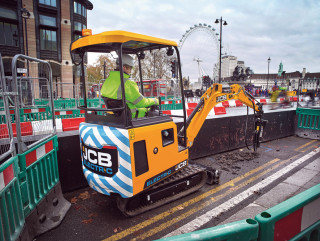
Volvo says this move makes it the first construction equipment manufacturer to commit to an electric future for its compact machine range and that the decision came after “an overwhelmingly favourable reaction from the market after the successful unveiling of a number of concept machines in recent years”.
So, the early part of Harrop’s thesis seems to be already happening, as manufacturers are strongly aware that electric vehicles have an increasing role to play in modern construction. As Alan Tolley, JCB group director of engines says: “Electric machines have an important niche role to play in the construction sector particularly with increasing urbanisation where they are operating more closely to people, digging underground and indoors.”
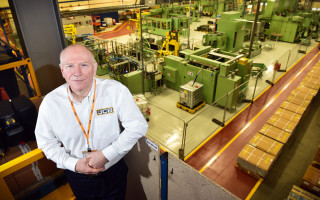
Yet there, perhaps, is where the growing popularity of electric vehicles still stops short – as niche vehicles only necessary in highly populated areas. This is not the vision that Harrop promulgates. Instead he sees electric vehicles becoming the norm over the next decade in every sphere of construction, with relatively small machines being simply the ‘early adopters’.
He cites examples such as the trial that the quarrying company Ciments Vigier is carrying out using a Komatsu 605-7, a 110-tonne dumper truck. The company spent more than US$1m (£760,000) retrofitting the truck with a synchronous electric motor capable of 590kW (800hp) of continuous power and up to 9,500Nm of torque.
Since last year, this prototype has been working in a quarry on the slopes of the Chasseral in Switzerland. The Swiss Federal Laboratories for Materials Science & Technology (EMPA) expect that the truck will be able to recuperate 40kWh of energy on its way down the quarry – something the truck does 20 times a day – for a total of 800kWh of energy capacity through regenerative braking. So, asks Harrop, if that can happen in a quarry then why should it not be possible on a construction site?
At this point, the manufacturers begin to defend diesel. JCB’s Alan Tolley, for instance, makes the case that diesel engines are becoming cleaner and are on their way to becoming comparable with electric. “Electric will have a part to play but clean diesel technology will continue to power the vast majority of machines,” he argues.
“When you compare electric to diesel, the latest Stage V JCB diesel engines have almost eradicated harmful emissions, with NOx down 97% and soot particulates down by 98% compared to 20 years ago.
“We have also reduced CO2 emissions by almost half (an improvement that is not required by legislation) by improving machine and engine efficiency. So with diesel, we are firmly on the road to zero.”
Even Volvo stresses that diesel combustion currently remains the most appropriate power source for its larger machines, though compromises might be required in order to meet the regulatory pressure that favours electrically powered machinery.

“The diesel combustion engine remains a very cost-efficient solution for creating mechanical energy. That said, legislation, especially in Europe, is pushing towards electrification quite strongly, and that may impact directly on the combustion engine’s longevity,” comments Dr Staffan Lundgren, senior technology advisor for powertrain at the Volvo Group.
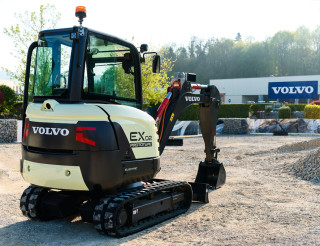
Yet that might be a long way in the future, according to other experts in the field. Alex Woodrow is managing director of Knibb, Gormezano & Partners (KGP), a specialist consultant to the global automotive industry, and he believes that there are some very basic practical issues that electric-powered vehicles would struggle to overcome.
The first big advantage that diesel has is its energy density: each litre of diesel is the equivalent of 3.28kWh of electrical energy. In practical terms that means a typical European 100kW tractor can carry enough fuel in a 100-litre tank to operate non-stop for eight hours. To do the same, that tractor would need to have the equivalent of four Tesla batteries, he says. And where would it recharge?
“Construction equipment is not like a saloon car,” Woodrow comments. “A Tesla would have to charge more than three times to cover 1,000 miles but a tractor – or any other equipment – can’t do that. Cars can already drive to fixed charging points but it’s far more difficult to set up those sorts of charging facilities on a temporary construction site.”
Increasing battery sizes would also carry their own health and safety risk. “What happens if a large piece of kit crashes onto a 500kWh battery?” he asks.
Nonetheless, Woodrow sees the market for electrically-driven construction equipment rising and, like Harrop, he recognises the importance of regulation in driving this. From January 2019 all newly-produced engines below 56kW must meet Stage V European emissions regulations whereas, before, emissions from engines of 20kW or below were not regulated at all.
“We expect to see a lot more electric models introduced. In many cases where these small machines are used indoors, electric makes sense and with these small machines the power requirements mean that the infrastructure for charging is not extensive,” says Woodrow.
“It’s as we get into the higher power segments that the requirements increase significantly and electric drive is less practicable.”
So for a while at least, the larger pieces of equipment found on construction sites are likely to remain entirely dependent on diesel technology. But further down the product ranges – in the midi and mini machines categories – there’s no doubt that the lure of hybrid and electric power is growing steadily stronger.
ELECTRIC TIMELINE
2003 Hitachi launches the world’s first hybrid wheel loader
2008 Komatsu announces the PC200-8, the world’s first hybrid excavator
2011 RDH begins manufacturing electric scoops for mining
2013 Hyundai Heavy Industries develops the ZH200-5B hybrid hydraulic excavator
JCB launches the JCB 19C-1 E- TEC, its first-ever electric excavator
2018 Volvo launches its electric compact excavator EX2
2019 Volvo announces that by mid-2020 it will begin to launch a range of electric compact excavators (EC15 to EC27) and wheel loaders (L20 to L28), and is stopping new diesel engine-based development of these models
Swedes’ ‘electric site’ yields savings
In October last year Volvo Construction Equipment and Swedish construction giant Skanska teamed up to work on an “electric site” research project at Skanska’s Vikan Kross quarry, near Gothenburg in Sweden.
Its aim was to electrify each transport operation – from excavation to primary crushing, and transport to secondary crushing.
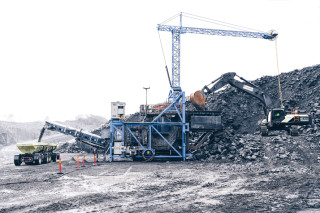
After just 10 weeks, the partners declared a 98% reduction in carbon emissions, better than the 95% originally predicted. There was also a 70% reduction in energy costs and a 40% reduction in operator costs.
Eight HX2 autonomous, battery-electric load carriers hauled the material from the primary mobile crusher up to the secondary static crusher.
These second-generation prototypes incorporate a lithium ion battery to power the two electric motors that drive the machine; the hydraulics are driven by an additional electric motor. The HX2 is fitted with a vision system, which allows it to detect humans and obstacles in its vicinity as it follows an adjustable, programmed GPS path.
The LX1 prototype electric hybrid wheel loader organised the piles of material at the site and improved fuel efficiency at the quarry by more than 50%, while significantly reducing both emissions and noise pollution.
Although it operates just like any other Volvo excavator, the EX1 70-tonne prototype that loaded the primary crusher at the quarry was fitted with an electric motor and was plugged into the grid, so it emitted zero emissions. The EX1 also had a diesel engine which, if the machine is not hooked up to an electricity source, it will start automatically.
Volvo says that collaborating with a customer such as Skanska to test prototype machines an early stage would enable it to accelerate development of new technologies.
This article was first published in the February 2019 issue of The Construction Index magazine
UK readers can have their own copy of the magazine, in real paper, posted through their letterbox each month by taking out an annual subscription for just £50 a year. Click for details.
Got a story? Email news@theconstructionindex.co.uk

